
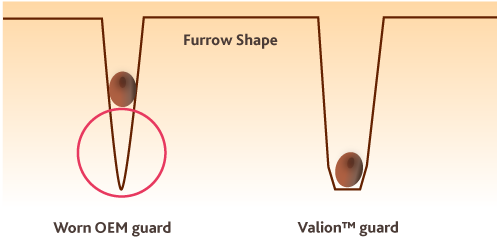
The Valion doesn’t form the furrow by pushing soil—it doesn’t drag below the blades, which would be very undesirable. Instead, the Valion keeps the lower edge of the blades at the optimum distance from each other so that the blades create a furrow of useful width, consistently, for uniform timing of emergence, resulting in higher yields.
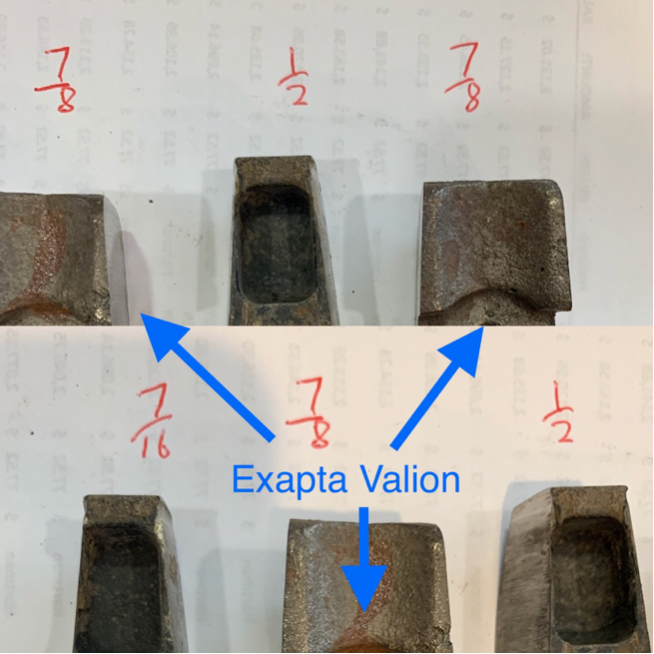
Side-by-side comparison of Valions vs Kinze 3000s OEM seed tube guards on a Kinze 3140 16-row planter, covering 500 acres. This is from an Exapta customer in Hooper, NE.

Valion™ seed tube guards from Exapta will eliminate seed tube wear and greatly reduce blade flex to create a properly shaped furrow and improved planting depth control. These guards are perfect for no-till or high-wear conditions, or anyone who is simply tired of replacing seed tube guards so often. While intended to limit blade flex, standard OEM seed tube guards can wear substantially in just a few hours of use (esp. older John Deere & Kinze). Our chrome Valions will outlast OEM guards by two to four times, so that furrows are properly shaped, and seeds placed at the correct depth continuously down the row, and all the way thru the planting season. (Valion Ultras—with tungsten carbide inlays—are discontinued for XP & ME5s, but still available for pre-XP and Kinze 2000s, while supplies last; these are a permanent fix, but not suited to rocky conditions.)
Liquid Capability Valions are also a slick way to apply liquids into the seed furrow (N/A on Kinze 3000 Valions). Here’s how to make this setup as trouble-free as possible, and more affordable and durable than competitor systems: Exapta’s Stainless Steel Liquid Tube Holders.

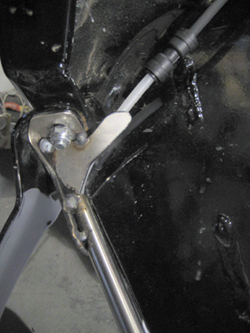
21″ Heat-resistant tubing puts connector alongside shank on Kinze 2000
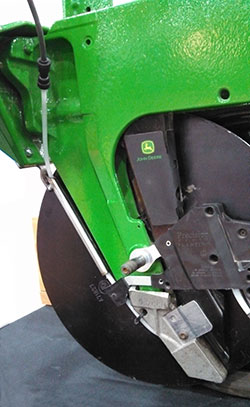
Connector alongside shank on Deere XP planter unit.
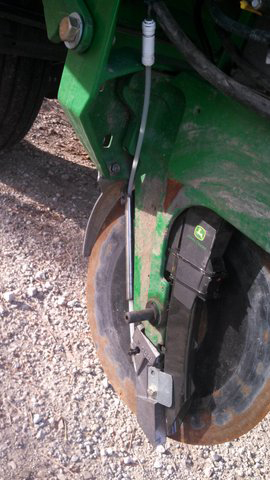
Connector above shank.

Note: We prefer applying liquids via Keetons. We view Keetons (or in-furrow ‘seed-lock’ wheels) as crucial for consistent stand establishment in no-till, and keeping those devices clean can be more of a challenge when liquids are applied ahead of them – although this is entirely dependent on liquid rate, stickiness of the liquid, and soil properties. However, many people get along just fine year after year applying liquids ahead of Keetons.
Note: Blade thickness affects the wear of any seed tube guard. Thicker blades slow the wear tremendously, because the rigidity of the blade increases as the cube of the thickness. So, it’s a huge difference between 3 vs 3.5mm blades, and again between 3.5mm vs 4mm. We strongly encourage going from 3 to 3.5mm if you haven’t already done so. And yet we’re not so thrilled with 4mm blades (standard on Monosem’s ‘French’ row unit) on double-disc planters. The 4mm blades don’t cut soil and residue as well as the 3.5s (this is especially true on Monosems, where the 4mm blades have a shallower bevel; if you want to convert those planters to using 3.5mm blades with Deere hubs, call us for a special bolt to make this conversion work).




Content of this page is copyright 2005-2025 Exapta Solutions, Inc. (reprint with written permission only).
Thompson wheel covered by U.S. Patent No. 6,907,833. Liquid delivery feature of Valion seed tube guards is U.S. Patent No. 8,978,564. Ninja seed bounce flap U.S. Patent Pending. UniForce U.S. Patent Pending. All rights reserved on other designs. Exapta is a registered trademark of Exapta Solutions, Inc. Keeton is a registered trademark of Precision Planting. Mojo Wire, Thompson wheel, Valion guard, Ninja flap, UniForce, DuraLok, No-till Seeding Explained, and No-till Seeding School are trademarks of Exapta. Disclaimer: Recommendations & page content are current, accurate, and believed to be broadly applicable as of the time of writing (Dec 2005) and last update (2005 – 2014). Because of diversity of soils, climate, crops, planter & drill models/designs marketed worldwide, combinations of attachments, etc., actual results may vary. No warranty is made as to actual results obtained. Should you encounter exceptions or worthwhile annotations to the statements made on this page, please contact us.




Derek is Kansas native who grew up in a 100% no-till farming operation. From an early age the benefits of no-till were made known to Derek by his father and by attending no-till conferences. From there he furthered his passion for soils while at Kansas State University getting his agronomy degree. He has had the experience of working in various roles and sectors of agriculture from sales and consulting to management, which have all been within production agriculture. Derek has also worked in specialty ag markets such as turf and ornamentals.
Sales & Service Representative
Prior to joining Exapta, Bob Pagel was an Agricultural Territory Sales Manager for Ritchie Brothers, serving parts of MN, WI and IA. He continues to support his family farm in SE Minnesota.
Current Product Engineer
Jonathan Zeller joined Exapta excited to return to working with no-till planting equipment. He supported research of no-till planting and other ag related projects for 7 years with Kansas State University’s Agricultural Engineering Department after getting his engineering degree. He later worked 3 years for Landoll Company, LLC. where he gained experience in a design engineering role. Jonathan grew up on a small family farm in NE Kansas working with row crops, hay and cattle. Jonathan enjoys solving engineering problems and improving or creating products to be robust and easy to install and service.